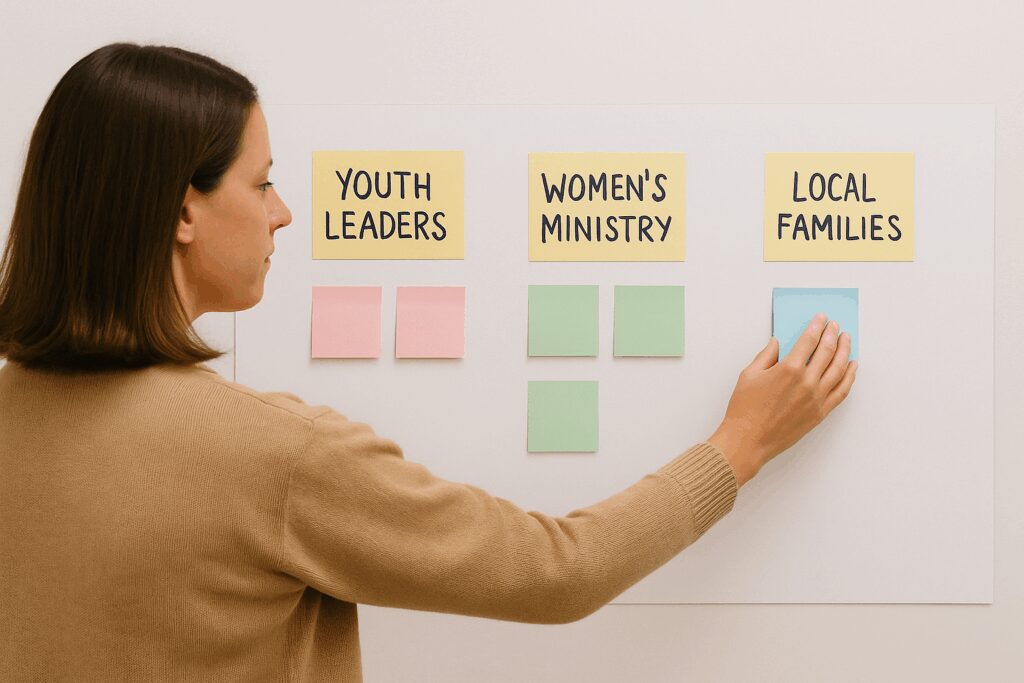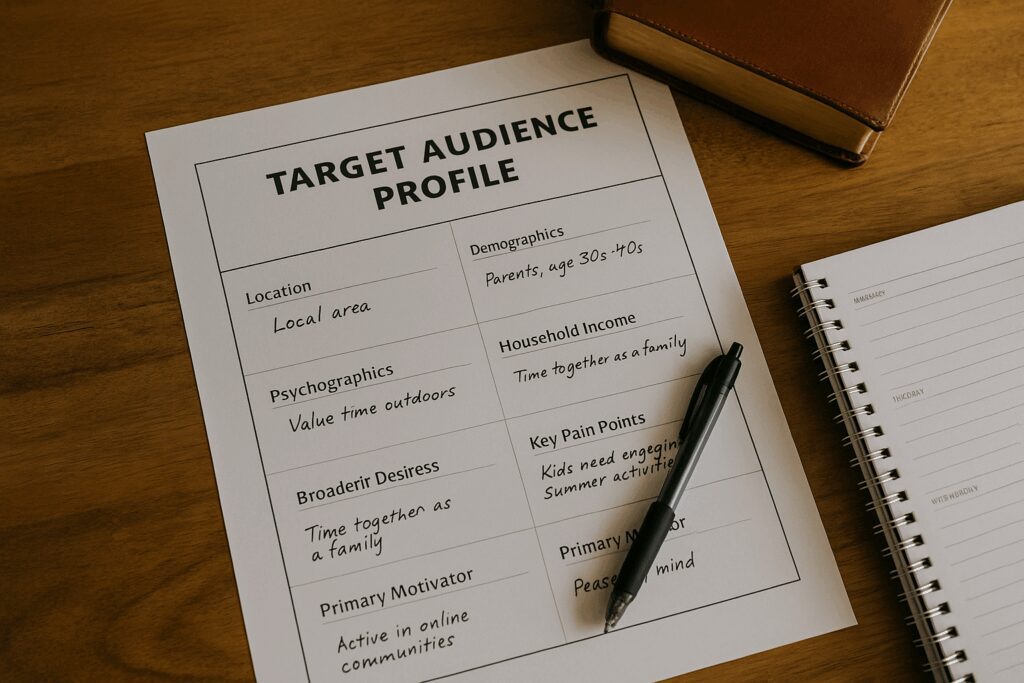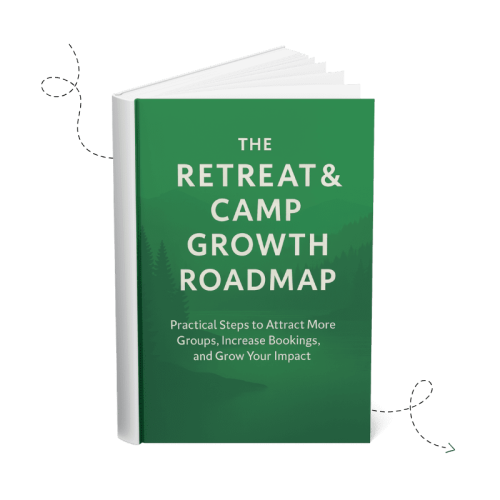Retreat & Camp Growth Roadmap Focus Area: Identify Your Audience
Introduction
If you’ve ever looked at a half-empty calendar and thought, “We know we’re meant to serve more groups—why aren’t they finding us?”—you’re not alone. Many retreat centers and camps struggle with attracting the right guests, not because they lack heart or quality programs, but because they’re trying to reach everyone at once.
The first focus area in the Retreat & Camp Growth Roadmap—Identify Your Audience—exists to fix that. Before you update your website, launch any ads, or redesign brochures, you need to clarify who you’re here to serve.
This article will walk you through a simple but powerful framework to help you define your audience in detail—and show how doing so can transform the way you attract and engage new guests.
Why This Focus Area Matters
Many organizations operate with vague assumptions about who their “target audience” is. The result:
- Broad, generic messaging that doesn’t connect with anyone
- Website content that lacks focus
- Ads that attract the wrong types of groups
- Leads that don’t convert—or don’t align with your mission
Here’s a common before-and-after snapshot:
Without Audience Clarity
- “We serve all Christian groups”
- Website has generic language
- Inquiries are inconsistent and mismatched
- Marketing feels scattered
With Audience Clarity
- “We help mid-size churches host leadership retreats within 2 hours of our center”
- Website speaks directly to group leaders
- Inquiries are more qualified and aligned with your mission
- Messaging is focused and effective
Audience clarity is the foundation of every future marketing decision. It helps you design better programs, write more persuasive content, and reach the people who are most likely to say “yes.”
Is This a Focus Area You Need to Work On Right Now?
Not sure if now is the right time to invest energy into clarifying your target audience? These questions can help you evaluate your current clarity:
- Can you describe your top 2–3 guest group types without hesitation?
- Does your team agree on who your ideal guests are and what they care about?
- Do your marketing efforts consistently attract the right kinds of inquiries?
- Are you confident that your website and ads speak to the people most likely to book?
- Do your most loyal guests reflect a clear audience segment—or is it more random?
If you answered “no” to any of these, this focus area is the right place to start.
When you take the time to clarify exactly who you serve, everything else gets easier. You’ll waste less time chasing misaligned leads, create marketing that actually connects, and grow your ministry more sustainably.
How to Begin When You’re Not Sure Who Exactly You Serve
If this kind of work is new to you, you might be thinking, “But we serve a little bit of everyone.” That’s okay. The goal here isn’t to exclude—it’s to focus.
Start by asking:
- Which guest groups come back year after year?
- Which events are easiest to book and run?
- Which types of leaders are easiest to work with?
- Who raves about their experience and refers others?
You don’t have to have data for everything. Talk to your team—especially those involved in bookings, guest services, and follow-up. Often, patterns will start to emerge.

Audience Profile Worksheet: 8 Questions to Guide You
Use the following questions to build a detailed profile of your ideal guest or group type. Aim to define at least 2–3 types.
- Location: Where do they live or operate? What’s their typical travel range?
- Demographics: Age range, gender, group type, family status, etc. (also industry and job title when targeting organizations)
- Psychographics: What are their values, behaviors, and decision-making style?
- Household Income (B2C) or Organization Size (B2B): This helps shape pricing and messaging. Define income levels when targeting individuals, such as for camps and member or employee headcounts when targeting organizations.
- Broader Desires: What’s the big-picture goal they’re trying to achieve?
- Key Pain Points: What are they frustrated by? What problems are they trying to solve?
- Primary Motivator: What ultimately drives them to book?
- Other Criteria: Anything else relevant—like timing, group size, or special needs?
📥 Want a printable version to share with your team?
[Download the Target Audience Profile Worksheet PDF]
Practical Examples
Let’s bring this to life through three target audiences commonly served by camps and retreat centers.
Summer Day Camp: Parents Seeking Safe, Faith-Based Summer Programming
This audience consists of Christian parents—mostly moms—in their late 20s to early 40s who live within a 15–30 minute drive of the camp. They are looking for structured, fun, and spiritually enriching summer activities for their elementary-aged children (ages 5–10). Many work part-time or full-time jobs and need dependable childcare during the week.
- Location: Local, within commuting distance
- Demographics: Married or single parents with young children
- Psychographics: Prioritize faith-based environments, safety, and developmental value
- Household Income: $50K–$100K; often budget-conscious
- Broader Desires: A summer filled with meaningful friendships, outdoor fun, and spiritual formation
- Key Pain Points: Screen time, lack of trustworthy childcare, need for routine during summer
- Primary Motivator: Confidence that their child will be safe, happy, and spiritually encouraged
- Other Criteria: Seek weekly flexibility, sibling discounts, early drop-off options
Christian Conference Center: Mid-Sized Church Leaders Planning Adult Retreats
This group includes associate pastors, ministry directors, and volunteer coordinators from mid-sized evangelical churches planning adult retreats. They typically organize events for 20–100 participants and prioritize spiritual growth, relationship building, and leadership development. Most are within a 2–5 hour drive of the conference center.
- Location: Regional reach (2–5 hours by car)
- Demographics: Ages 30–60; ministry professionals or lay leaders
- Psychographics: Want simplicity, hospitality, and a setting that fosters spiritual depth
- Organization Size: Churches with 100–500 members
- Broader Desires: Strengthen their community through meaningful, distraction-free retreats
- Key Pain Points: Limited staff to handle logistics; hard to find spiritually aligned venues
- Primary Motivator: Hosting a retreat that reflects well on the organizer and feeds the group
- Other Criteria: Value onsite support, quality meals, AV tech, and customizable retreat formats
Youth Overnight Camp: Churches and Ministries Running Teen Discipleship Events
This target audience includes youth pastors and church volunteer leaders who coordinate summer or weekend overnight retreats for middle and high school students. They are looking for experiences that combine spiritual impact with high-energy activities in a safe, Gospel-centered environment. Most operate within a 2–3 hour radius of the camp.
- Location: Primarily in-state or within a 2–3 hour drive
- Demographics: Church youth ministries; teens ages 12–17
- Psychographics: Value fun, safety, spiritual transformation, and leader support
- Organization Size: Youth groups ranging from 20 to 100 students
- Broader Desires: Help teens encounter God and build community through shared experiences
- Key Pain Points: Limited budgets, safety concerns, volunteer-dependent planning
- Primary Motivator: A trusted retreat experience that will energize and disciple their students
- Other Criteria: Often require scholarships, prebuilt programming, and staff involvement

Case Study: Clarity in Action
A Christian retreat center in Pennsylvania was struggling to fill midweek bookings during their offseason. They had strong weekend bookings, but Moday’s through Thursdays sat empty.
After reviewing their event data for the past few years, they noticed a pattern for midweek bookings: school groups, business groups, and church groups of certain ethnicities were showing up with midweek bookings. They decided to focus on developing relationships with organizations in these segments to increase midweek bookings.
First, they built landing pages for school field trips and corporate team building event. Then they launched ad campaigns promoting those services to these target groups. They also began a proactive outreach campaign to church groups similar to those that were known for booking midweek retreats.
As a result, they significantly increased the volume of midweek bookings and now have consistent bookings year round. It wasn’t an overnight change – but as more groups booked and had a good experience, they referred them to others in their group. And now several years later, they don’t have to invest as much in proactive marketing for these groups because they have already built up a reputation in those segments.
Audience Clarity Self-Check
Ask yourself:
- Can I name the top 2–3 group types we serve best?
- Do I know where they live, what they value, and what they struggle with?
- Could someone on our team describe our audience in detail?
- Does my website speak directly to their needs?
- Does our marketing target those specific people?
If you answered “no” to more than one—this focus area is your next best step.
Practical Takeaways
- Choose 2–3 ideal guest types to define in detail
- Use the 8-question framework to build full profiles
- Discuss findings with your team and revisit annually
- Use your audience insights to shape messaging, offers, and targeting
- Let this clarity guide your next steps—especially in messaging and web content
Final Thoughts & Next Steps
Audience clarity isn’t just a marketing task—it’s a ministry decision. When you know exactly who you’re trying to reach, you can serve them more meaningfully, communicate more clearly, and grow more sustainably.
This focus area lays the groundwork for everything that follows—from website content to ads to programming.
Next: Use these profiles to refine your message in Craft Brand Messaging—the next focus area in Step 1 of the Retreat & Camp Growth Roadmap, Define Your Strategy.
Ready to Take the Next Step?
Identifying your audience is just the beginning—but it’s a powerful one. With this clarity, you can shape every part of your marketing to serve the right guests more effectively.
If you found this helpful, here are four great next steps to continue your journey:
🧭 Move to the Next Focus Area: Craft Brand Messaging
Now that you know who you’re serving, learn how to speak to them clearly and compellingly in all your communications.
[Read Craft Brand Messaging]
📘 Download the Retreat & Camp Growth Roadmap eBook
Get the full 3-stage system we use to help Christian retreat centers and camps grow with clarity and purpose.
[Download the eBook]
🌱 Learn More About How We Help Retreat Centers & Camps
We’re a Christian-owned marketing agency that specializes in helping ministries grow attendance, bookings, and impact through practical strategies rooted in clarity and stewardship.
[See How We Can Help]
🤝 Schedule a Free Discovery Call
Want help applying this to your unique situation? Let’s talk. We’ll explore where you are now, where you want to go, and how to take the next faithful step.
[Book a Discovery Call]
You don’t have to figure this out alone. Let’s build something meaningful—together.
Frequently Asked Questions
What if we serve a wide range of group types? Isn’t it limiting to focus on just a few?
Not at all. Focusing doesn’t mean excluding. It means leading with clarity. You can still serve a wide range of groups—but your messaging and outreach will be most effective when it’s tailored to the guests who are the best fit and most likely to book. Think of this as clarifying your core audiences, not your only audiences.
How many audiences should we define?
We recommend starting with 2–3 clearly defined audiences. This gives you focus without overcomplicating your strategy. You can always expand later, but start with the groups you know best and serve most effectively.
Should each program have its own audience?
Yes—ideally. If your retreat center offers different programs (like summer camp, family weekends, or leadership retreats), each one may appeal to a different group. You can use the same 8-question framework to build a profile for each.
What if we don’t have much data to work with?
Use what you do have—past bookings, staff observations, guest feedback, or even your own instincts. Start with anecdotal evidence and refine over time. You don’t need perfect data to get meaningful clarity.
What’s the difference between a “persona” and a “target audience”?
A target audience is a segment of people with shared traits. A persona is a fictional example of one person within that group. Both are useful, but in this context, we’re focusing on audiences—because they guide strategic decisions more effectively at the organizational level.
Can I use this with my team?
Absolutely. This process works best when done collaboratively. Download the worksheet, gather your staff, and work through it together. You’ll likely uncover insights that shape not just marketing—but programming and guest services too.
How do we validate that we’ve chosen the right audiences?
Watch for alignment between who you target and who actually books. Are they showing up? Are they converting? Are they satisfied and referring others? If so, you’re likely on the right track. If not, refine your audience definitions and test again.
Is this only for larger centers with marketing budgets?
No. Audience clarity is even more essential for smaller ministries with limited resources. When you know exactly who you’re trying to reach, you waste less time and money—and you grow more intentionally.
What tools can help us document and use our audience profiles?
Start with our free worksheet, then store your profiles in a shared Google Doc or CRM system. Use them to guide content creation, ad targeting, sales conversations, and website design.
Where should we apply our audience insights first?
Begin with your website and any ads you’re running. Does the language reflect your audience’s pain points and motivators? Then use the same language in emails, brochures, social media, and sales scripts





